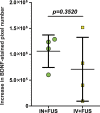Focused ultrasound-enhanced intranasal brain delivery of brain-derived neurotrophic factor
- PMID: 27345430
- PMCID: PMC4921840
- DOI: 10.1038/srep28599
Focused ultrasound-enhanced intranasal brain delivery of brain-derived neurotrophic factor
Abstract
The objective of this study was to unveil the potential mechanism of focused ultrasound (FUS)-enhanced intranasal (IN) brain drug delivery and assess its feasibility in the delivery of therapeutic molecules. Delivery outcomes of fluorescently-labeled dextrans to mouse brains by IN administration either before or after FUS sonication were compared to evaluate whether FUS enhances IN delivery by active pumping or passive diffusion. Fluorescence imaging of brain slices found that IN administration followed by FUS sonication achieved significantly higher delivery than IN administration only, while pre-treatment by FUS sonication followed by IN administration was not significantly different from IN administration only. Brain-derived neurotrophic factor (BDNF), a promising neurotrophic factor for the treatment of many central nervous system diseases, was delivered by IN followed by FUS to demonstrate the feasibility of this technique and compared with the established FUS technique where drugs are injected intravenously. Immunohistochemistry staining of BDNF revealed that FUS-enhanced IN delivery achieved similar locally enhanced delivery as the established FUS technique. This study suggested that FUS enhances IN brain drug delivery by FUS-induced active pumping of the drug and demonstrated that FUS-enhanced IN delivery is a promising technique for noninvasive and localized delivery of therapeutic molecules to the brain.
Figures






References
-
- Pardridge W. M. Drug targeting to the brain. Pharm. Res. 24, 1733–44 (2007). - PubMed
-
- Lochhead J. J. & Thorne R. G. Intranasal delivery of biologics to the central nervous system. Adv. Drug Deliv. Rev. 64, 614–28 (2012). - PubMed
-
- Thorne R. G. & Frey W. H. II Delivery of neurotrophic factors to pharmacokinetic considerations. Clin Pharrmacokinet 40, 907–946 (2001). - PubMed
-
- Pires A., Fortuna A., Alves G. & Falcão A. Intranasal drug delivery: how, why and what for? J. Pharm. Pharm. Sci. 12, 288–311 (2009). - PubMed
-
- Nagahara A. H. & Tuszynski M. H. Potential therapeutic uses of BDNF in neurological and psychiatric disorders. Nat. Rev. Drug Discov. 10, 209–19 (2011). - PubMed
Publication types
MeSH terms
Substances
Grants and funding
LinkOut - more resources
Full Text Sources
Other Literature Sources

